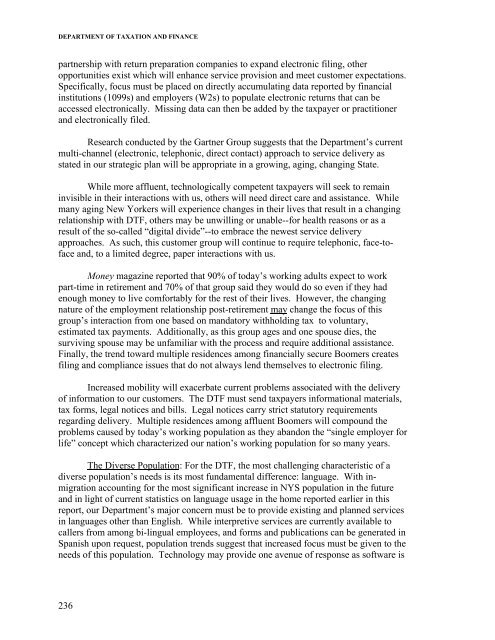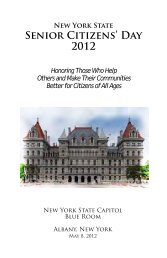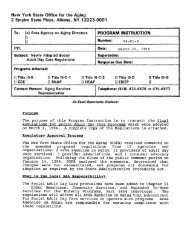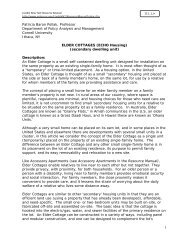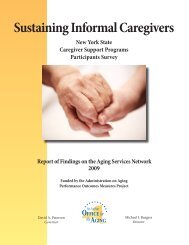White Paper - New York State Office for the Aging
White Paper - New York State Office for the Aging
White Paper - New York State Office for the Aging
- No tags were found...
You also want an ePaper? Increase the reach of your titles
YUMPU automatically turns print PDFs into web optimized ePapers that Google loves.
DEPARTMENT OF TAXATION AND FINANCE<br />
partnership with return preparation companies to expand electronic filing, o<strong>the</strong>r<br />
opportunities exist which will enhance service provision and meet customer expectations.<br />
Specifically, focus must be placed on directly accumulating data reported by financial<br />
institutions (1099s) and employers (W2s) to populate electronic returns that can be<br />
accessed electronically. Missing data can <strong>the</strong>n be added by <strong>the</strong> taxpayer or practitioner<br />
and electronically filed.<br />
Research conducted by <strong>the</strong> Gartner Group suggests that <strong>the</strong> Department’s current<br />
multi-channel (electronic, telephonic, direct contact) approach to service delivery as<br />
stated in our strategic plan will be appropriate in a growing, aging, changing <strong>State</strong>.<br />
While more affluent, technologically competent taxpayers will seek to remain<br />
invisible in <strong>the</strong>ir interactions with us, o<strong>the</strong>rs will need direct care and assistance. While<br />
many aging <strong>New</strong> <strong>York</strong>ers will experience changes in <strong>the</strong>ir lives that result in a changing<br />
relationship with DTF, o<strong>the</strong>rs may be unwilling or unable--<strong>for</strong> health reasons or as a<br />
result of <strong>the</strong> so-called “digital divide”--to embrace <strong>the</strong> newest service delivery<br />
approaches. As such, this customer group will continue to require telephonic, face-toface<br />
and, to a limited degree, paper interactions with us.<br />
Money magazine reported that 90% of today’s working adults expect to work<br />
part-time in retirement and 70% of that group said <strong>the</strong>y would do so even if <strong>the</strong>y had<br />
enough money to live com<strong>for</strong>tably <strong>for</strong> <strong>the</strong> rest of <strong>the</strong>ir lives. However, <strong>the</strong> changing<br />
nature of <strong>the</strong> employment relationship post-retirement may change <strong>the</strong> focus of this<br />
group’s interaction from one based on mandatory withholding tax to voluntary,<br />
estimated tax payments. Additionally, as this group ages and one spouse dies, <strong>the</strong><br />
surviving spouse may be unfamiliar with <strong>the</strong> process and require additional assistance.<br />
Finally, <strong>the</strong> trend toward multiple residences among financially secure Boomers creates<br />
filing and compliance issues that do not always lend <strong>the</strong>mselves to electronic filing.<br />
Increased mobility will exacerbate current problems associated with <strong>the</strong> delivery<br />
of in<strong>for</strong>mation to our customers. The DTF must send taxpayers in<strong>for</strong>mational materials,<br />
tax <strong>for</strong>ms, legal notices and bills. Legal notices carry strict statutory requirements<br />
regarding delivery. Multiple residences among affluent Boomers will compound <strong>the</strong><br />
problems caused by today’s working population as <strong>the</strong>y abandon <strong>the</strong> “single employer <strong>for</strong><br />
life” concept which characterized our nation’s working population <strong>for</strong> so many years.<br />
The Diverse Population: For <strong>the</strong> DTF, <strong>the</strong> most challenging characteristic of a<br />
diverse population’s needs is its most fundamental difference: language. With inmigration<br />
accounting <strong>for</strong> <strong>the</strong> most significant increase in NYS population in <strong>the</strong> future<br />
and in light of current statistics on language usage in <strong>the</strong> home reported earlier in this<br />
report, our Department’s major concern must be to provide existing and planned services<br />
in languages o<strong>the</strong>r than English. While interpretive services are currently available to<br />
callers from among bi-lingual employees, and <strong>for</strong>ms and publications can be generated in<br />
Spanish upon request, population trends suggest that increased focus must be given to <strong>the</strong><br />
needs of this population. Technology may provide one avenue of response as software is<br />
236


